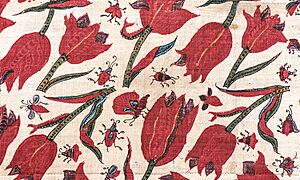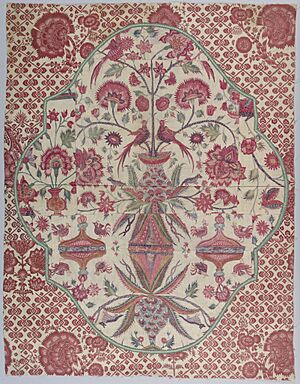Chintz facts for kids
Chintz is a special type of calico fabric. It started in India in the 1500s. This cloth is often printed with colorful flowers and other designs. These patterns usually appear on a light, plain background. Chintz can be printed, painted, or even given a shiny finish.
Contents
What's in a Name?
The word "chintz" comes from the Hindi word chīṁṭ. This word means "spotted" or "speckled." So, the name describes the fabric's patterned look.
For a long time, chintz meant this specific Indian fabric. But over time, the word also started to describe the style of floral designs found on it. You can see these designs on pottery, called chintzware, and even on wallpaper. These patterns were inspired by Mughal art from India. They often feature flowers and animals on a white background.
Sometimes, people use the word "chintzy" to describe something that looks cheap or old-fashioned. This idea came from when cheaper copies of real chintz were made in Europe.
A Look at Chintz History
Chintz was first made in Hyderabad, India, between 1600 and 1800. It was very popular for things like bed covers and draperies. European traders like the Portuguese and Dutch first brought chintz to Europe around 1600. Later, English and French merchants started importing huge amounts of it. By 1680, over a million pieces of chintz were coming into England each year!
Europeans loved chintz for curtains, furniture covers, and bedspreads. People even started wearing it as clothes. Some say it became clothing when old bedspreads were given to servants, who then turned them into dresses.
The Chintz Bans
The popularity of chintz worried fabric makers in France and England. They didn't know how to make this special fabric themselves. So, in 1686, France banned all chintz imports. England followed in 1720 with a law that stopped people from wearing or using imported chintz for furniture. Spain also banned chintz imports to protect its own textile industry.
Even with these bans, chintz was still popular. For example, people at the royal court in Versailles, France, kept wearing it because they were outside the law.
How Europeans Learned to Make Chintz
Europeans really wanted to learn how to make chintz. In 1734, a French naval officer named M. de Beaulieu sent detailed letters and fabric samples from India. He explained the whole process of dyeing cotton chintz. You can still see his letters and samples in a museum in Paris today.
Another Frenchman, Father Coeurdoux, also shared details about chintz making in 1742. Finally, in 1759, the ban on chintz was lifted. By this time, French and English factories had learned how to produce their own chintz.
At first, European factories copied Indian designs. But later, they created their own unique patterns. One famous European chintz was called Toile de Jouy, made in France. Today, modern chintz often has bright floral patterns on a light background. Some popular designs also use black backgrounds.
See also
- Peshgeer
Images for kids
-
Chintz from the Coromandel Coast, India, made around 1710–1725.









